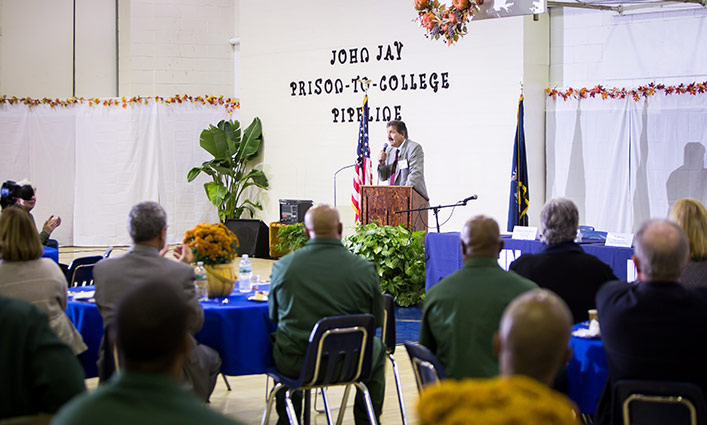
At the Otisville Correctional Facility, students enrolled in the Prison-To-College-Pipeline (P2CP) anxiously waited to greet a group of visitors who had traveled to the prison specifically to meet them.
“This is a special event,” said Dylan Knapp, a current P2CP student who was scheduled to speak on a panel later in the afternoon. “We’ve spent a lot of time preparing for this.”
The visit was hosted by the Prisoner Reentry Institute (PRI) at John Jay College and by the NYS Department of Corrections and Community Supervision (DOCCS) as an opportunity for various stakeholders—including John Jay College President Karol Mason, city and state officials, corrections professionals, educators, students, and funders—to learn more about the impact of the ground-breaking P2CP program, which allows incarcerated people to begin their college careers while still incarcerated and finish them upon release. Since its beginning in 2011, the program has garnered the support of various foundations including the David Rockefeller Fund, the Ford Foundation, JM Kaplan Fund, the Teagle Foundation, the Pinkerton Foundation, and more.
“It has not been easy but today is a milestone, and we take pleasure in what we have achieved,” said Otisville Superintendent Kathleen Gerbing.
“It takes a community to pull this off,” added Ann Jacobs, Director of PRI.
That community effort begins with a recruitment process that extends to five prisons across the state. Applicants who pass the CUNY admissions tests in reading and writing submit an essay and are interviewed. Once accepted, students are transferred to Otisville, and begin the three-part program: credit-bearing classes taught by professors that travel to Otisville on a weekly basis, a monthly learning exchange with John Jay students who come to the prison for seminars with the incarcerated students, and a workshop series in which P2CP students receive academic advisement and practice skills for success in college and beyond.
“We want students to have a rich campus experience like all other CUNY students,” said Bianca Van Heydoorn, Director of Educational Initiatives at PRI.
As a result, P2CP students gain access to a comprehensive set of resources and myriad opportunities to learn. That learning extends not just to the students inside, but also to those who participate in the exchange program, who often have an equally life-altering experience.
“I grew up believing that people deserved to be put away,” said Nino Pereira, a John Jay student who participated in the learning exchange program in 2016. “This program showed me that I had biases against incarcerated people, and forced me to face them.”
P2CP’s impact extends well after students complete the program. After graduation, students have access to the College Initiative (CI) program, which provides outreach, academic counseling, financial aid and enrollment assistance, peer mentoring, and supportive workshops. Both P2CP and CI are committed to providing support at each step of the way.
“I’ve gotten support through this program to keep being resilient,” said Dino Solorzano, a second year student of P2CP. “John Jay and the professors who teach us are here to say this is not just school—this is family.”
That sense of family was clear throughout the visit as returning graduates of P2CP took turns greeting friends they’d met through the program, some of whom were still incarcerated. Deivy Tauzard, who was seeing the prison for the first time since his release, turned to Knapp with advice. “Take advantage of these opportunities,” he said. “This program is hope.”
Fortunately, the program continues to grow. In 2016, an experimental pilot program called the Second Chance Pell was launched to give incarcerated people the opportunity to receive Pell grants to fund their college education. John Jay College was selected as the lead institution for CUNY, and became one of 67 universities nationwide to participate in the program.
“Under the Obama administration, we started the Second Chance Pell,” said John Jay President Karol Mason, recalling her experience as former U.S. Assistant Attorney General. “The Prison-to-College-Pipeline is confirming that what we thought was important in theory is important in practice.”
With the federal Second Chance Pell Pilot expansion, the P2CP academic program has grown to 52 students this fall, and is slated to expand to 100 students in the fall of 2018, and to 150 students in fall 2019.
Theron Smith, who was part of the program’s first cohort in 2011, is excited to see it expand. “From 15 students to 30 to 40, I’ve already seen the program grow so much,” he said.
Dr. Baz Dreisinger, the Founding Academic Director of the program, thinks there’s a good reason that the program continues to grow—it’s because the model works. At the time of this visit, she was in Taiwan to talk about replicating the innovative P2CP model in that country, but her presence was still felt.
“Six years ago, we couldn’t have imagined how powerful the program would become—not just here—but internationally,” Dreisinger stated. “We should all be vastly proud.”



